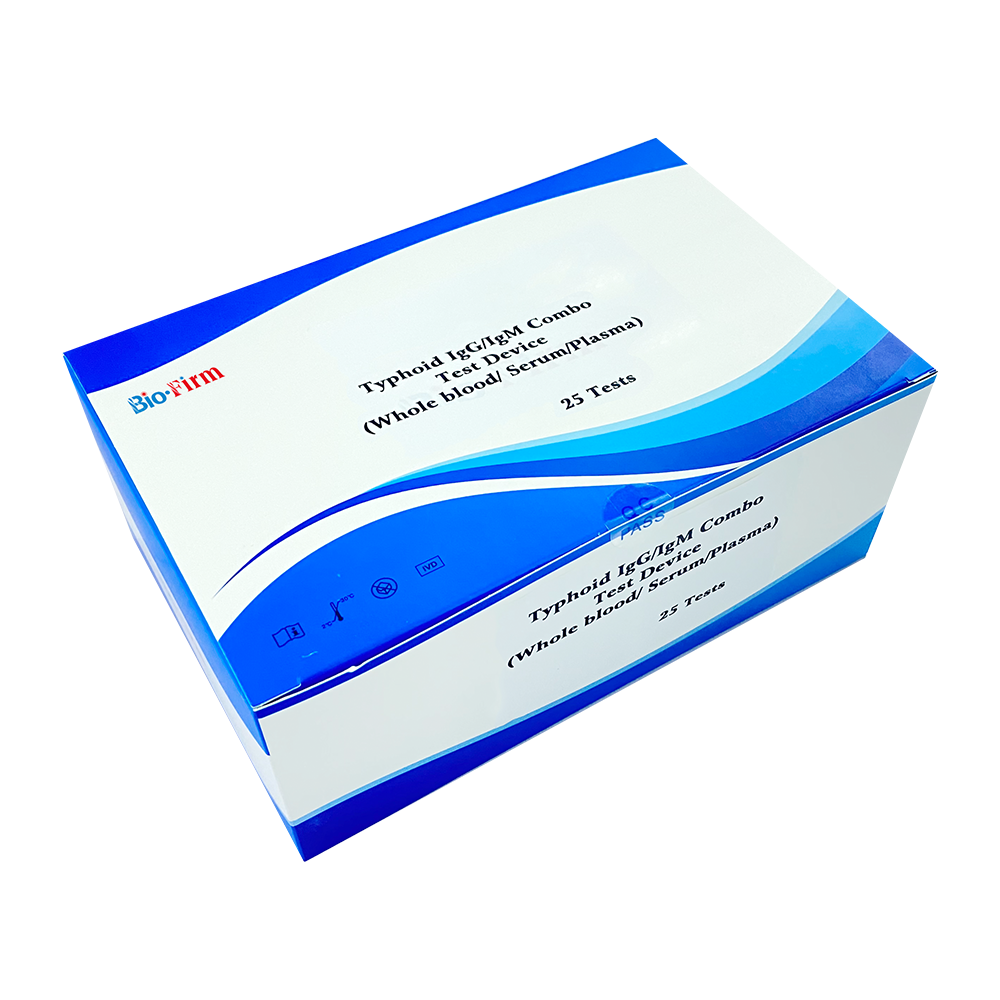Jul 01,2022
Typhoid fever remains a significant public health concern in many developing countries, with millions of infections reported annually. Caused by Salmonella enterica serotype Typhi (S. Typhi), the disease is transmitted via contaminated food and water and manifests with prolonged fever, malaise, abdominal pain, and other systemic symptoms. Early diagnosis is essential for effective treatment and reducing transmission. Among available diagnostic methods, the Typhoid IgG/IgM Rapid Test offers a fast, cost-effective, and point-of-care solution for the qualitative detection of anti-S. Typhi antibodies in human blood specimens.
This article provides a detailed overview of the Typhoid IgG/IgM Rapid Test, including its working principle, clinical relevance, test procedure, advantages, limitations, and its role in public health and epidemiological surveillance.
1. Overview of Typhoid Fever and the Immune Response
Typhoid fever is primarily transmitted through the fecal-oral route. After ingestion, S. Typhi invades the intestinal mucosa and spreads systemically via the lymphatic and circulatory systems. The host immune system responds by producing specific antibodies.
IgM antibodies are produced early in the infection, typically within 4–7 days, indicating recent or acute infection. IgG antibodies appear later and may persist for months or even years, suggesting past infection or long-standing immune response.
Detection of these antibodies forms the basis of serological diagnosis. While blood culture remains the gold standard, its sensitivity is limited, especially after antibiotic administration. In contrast, serological rapid tests allow timely screening in resource-limited settings.
2. What Is the Typhoid IgG/IgM Rapid Test?
The Typhoid IgG/IgM Rapid Test is a lateral flow immunoassay (LFIA) designed to qualitatively detect IgG and IgM antibodies specific to Salmonella Typhi in human serum, plasma, or whole blood.
This test employs recombinant S. Typhi antigens immobilized on a test membrane to capture specific antibodies from the patient sample. The visual signal, typically in the form of colored lines, indicates the presence or absence of the target antibodies, allowing clinicians to distinguish between acute and past infections within 10–20 minutes.
3. Principle of the Assay
The assay operates on immunochromatographic principles and consists of the following components:
-
Sample Pad: Where the patient sample is applied.
-
Conjugate Pad: Contains colloidal gold or latex particles conjugated with S. Typhi antigens.
-
Nitrocellulose Membrane: Coated with anti-human IgM and IgG antibodies at separate lines (M and G), and a control line (C).
-
Absorbent Pad: Draws the sample across the membrane through capillary action.
Test procedure:
-
A few drops of whole blood, serum, or plasma are added to the sample well.
-
A buffer solution is added to facilitate flow.
-
If S. Typhi-specific IgM or IgG antibodies are present, they bind to antigen-conjugated particles and are captured at the respective lines.
-
A colored line at the M (IgM) or G (IgG) position indicates a positive result. A line at the C position confirms the validity of the test.

4. Interpretation of Results
| Test Line Appearance | Interpretation |
|---|---|
| C + M only | Positive for IgM (acute infection) |
| C + G only | Positive for IgG (past exposure) |
| C + M + G | IgM and IgG positive (ongoing or recent infection) |
| C only | Negative |
| No C line | Invalid test |
5.1 Early Diagnosis
Detection of IgM enables identification of recent infections, allowing for early therapeutic intervention even before blood culture results are available.
5.2 Screening in Endemic Areas
The test is particularly valuable in endemic regions with limited access to laboratory facilities, enabling healthcare providers to make rapid decisions at the point of care.
5.3 Differentiation Between Current and Past Infections
By distinguishing IgG from IgM, clinicians can better assess disease stage, past exposure, or recovery status.
5.4 Outbreak Investigation and Surveillance
Rapid tests support epidemiological surveillance and outbreak control, especially in refugee camps or post-disaster areas with high risk of waterborne diseases.
6. Advantages of Typhoid IgG/IgM Rapid Test
-
Rapid Results: Provides qualitative results within 15–20 minutes.
-
Simplicity: Requires no specialized equipment or highly trained personnel.
-
Specimen Flexibility: Works with whole blood, plasma, or serum.
-
Portability: Useful in field settings, rural clinics, and mobile healthcare units.
-
Cost-Effective: Affordable alternative to culture or ELISA-based methods.
-
Dual Detection: Simultaneously detects both IgG and IgM for improved diagnostic accuracy.
7. Limitations
Despite its convenience, the rapid test has some limitations:
-
Lower Specificity and Sensitivity: Compared to blood culture or molecular diagnostics, false positives may occur due to cross-reactivity with other Salmonella species or infections (e.g., malaria, dengue).
-
Cannot Replace Culture for Antimicrobial Sensitivity Testing: Does not provide information on bacterial resistance profiles.
-
Timing Dependency: Testing too early in infection may yield false negatives before the immune response develops.
-
Persistent IgG Positivity: May complicate differentiation between past and chronic infections.
Thus, the rapid test is best used in conjunction with clinical assessment and, when possible, follow-up with confirmatory testing.
8. Comparison with Other Diagnostic Methods
| Diagnostic Method | Time to Result | Sensitivity | Specificity | Equipment Required | Antibiotic Influence | Use Case |
|---|---|---|---|---|---|---|
| Blood Culture | 2–5 days | Moderate | High | Yes | Yes | Gold standard |
| Widal Test | 1–2 hours | Low | Low | Minimal | Yes | Outdated |
| PCR | <4 hours | Very High | Very High | Advanced lab | Minimal | High-end labs |
| Typhoid Rapid Test | <20 minutes | Moderate | Moderate | None | Yes | Field/POC |
Manufacturers of Typhoid IgG/IgM Rapid Tests must comply with the following international standards:
-
ISO 13485 for medical device quality systems
-
CE marking for distribution in Europe
-
US FDA registration (if applicable)
-
WHO prequalification for use in global health programs
-
Validation with clinically confirmed specimens, following CLSI and IVD guidelines



 Español
Español
 Français
Français
 Deutsch
Deutsch
 عربى
عربى








